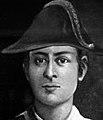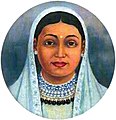Bagale Thapa
| Bagāle Thāpā/Bagālyā Thāpā | |
|---|---|
| बगाले थापा/बगाल्या थापा | |
 Coat of arms of Bagale Thapa clan | |
| Jāti | Chhetri |
| Classification | Jharra |
| Gotra | Atreya Gotra[1] |
| Veda | Shukla Yajurveda[2] |
| Kuladevta (male) | Mahadev |
| Kuladevi (female) | Kalika Bhavani |
| Languages | Nepali, Dotyali, Kumaoni |
| Family names | Thapa, Bagale Thapa |
| Heraldic title | Thapa Kaji |
| Throne | Takam State (1189- 1488 CE)[3][2] |
| Victory weapon | Khunda and Khukuri |
| Related groups | Kunwars, Ranas, Pandes, Basnyats & sundry Kshetris |
| Status | Kshatriya |
Bagale Thapa (Nepali: बगाले थापा pronunciation:[bʌgale t̪ʰapa]) anciently known as Bagalya Thapa (Nepali: बगाल्या थापा) is a prominent clan within Thapa of Magar caste and Thapa of Khas Chhetri community.[4] They claim Atreya Gotra.[1][2] The name of the clan is also transliterated as Bagale, Bagalya, Bagaalya, Bagaliya, Bagaley, Bagaale or Bagaleya.
Family of Bhimsen Thapa[4] and family of Amar Singh Thapa[1] were two influential Bagale Thapa families at the centre of politics in Kingdom of Nepal.[5]
Origins
Bagale Thapa genealogy
....श्री शाकेः ।। ११११ सम्वत् १२४६ साल देषि थापाहरूका सन्तति कुलका आदि कालु थापा [ne] हुनः ।। १ ।। कालु थापाका चेला ४ जेठा पुन्याकर थापाः ।। माहिँला तारापति थापाः ।। साहिँला विरु थापाः ।। कान्छा धर्मराज थापाः ।। पुलामका जेठा हुनः ।। ताकमका माहिँला हुनः ।। जमरिकका कान्छा जसोधर थापा (धर्मराज) हुनः तिनले जमरिकमा राज्य गर्याः ताहाँ देषि तिनी आयाका हुनः ।। २ ।।.....
Bagale Thapa Vamsāwali (genealogy) part republished by Yogi Naraharinath[2]

The genealogy traces the lineage of all Bagale Thapas to a male progenitor (Mūlapuruṣa) Kalu Thapa Kshatri. The genealogy states that Kalu Thapa had four sons; Punyakar of Pulaam state, Tarapati of Takam state, Biru and Dharmaraj (Jashodhar) of Jamarik state.[2] The genealogy describes that Kaalu adhered to the following sects: "Aatreya gotri Tripravara, Shukla Yajurveda, Dhanurveda and Madhyandini Shakha".[2]
Kunwar family legend
Kunwar family legend mentions that their first ancestor Rāma Siṃha Rāṇā was married to a daughter of Raja (King) of Bīnātī, a Bagāle Kṣetrī on the request by his employer hill Raja.[6] John Whelpton opines that the legend of the Kunwar family's origins, which says their progenitor to have entered hill and married a daughter of Bagale Kshetri, might have linked their family to the Bagale Thapa, a clan of the Mukhtiyar Bhimsen Thapa.[7]
History

Khas Thapas belong to the Chhetri caste of the Kshatriya Varna whose origin lies in Karnali region of Khas Kingdom. Bagale Thapas were a powerful and prominent family at Jumla and seemed to have migrated eastwards.[4]
Takam/Takamkot State
Takam State (1246-1545 B.S.) (1189-1488 CE) was used as an arsenal by the Bagale Thapa clan. In 1545 B.S. (1488 CE), King Dimba Bam Malla defeated these Thapas and annexed all the districts of Dhawalagiri Zone to create a bigger Parbat State.[8] The Bagale Thapa clan of Takamkot established their arsenal in this Takamkot (Takam State) and controlled it between 1189 and 1488 CE, after which the Malla kings captured and controlled it from 1489 to 1825 CE.[3]
Malla era Kathmandu
In the times of Malla rule at Kathmandu valley, Bagale Thapas were considered skillful at both warfare and administration. Thus, King Jagajjaya Malla attended the services of Kashiram Thapa, a leader of Bagale Thapas to control inobedient Khas and Magar citizens.[9] His brother Parashuram Thapa, a commander of Bhaktapur Kingdom, sided to Gorkha Kingdom when Kashiram Thapa was killed without justification.[10]
Noble families in Gorkha

Family of Bhimsen Thapa[4] and family of Amar Singh Thapa[1] were two influential Bagale Thapa families at the central politics of Kingdom of Nepal.[5]
The family of Bada Kaji Amar Singh Thapa consists Kaji Ranajor Singh Thapa, Ranadhoj Thapa, Narsingh Bahadur Thapa and their 2 more brothers who were also at Royal Court of Nepal.[11] Amar Singh Thapa[12], one of the National heroes of Nepal[13] and commander of Western front at Anglo-Nepalese war belonged to this clan.[1]
The family of Kaji Bir Bhadra Thapa, commander of Unification of Nepal belonged to this clan. This family contains large number of renowned courtiers and warriors. He had three sons: Jeevan Thapa(died at Battle of Kirtipur), Bangsha Raj Thapa and Amar Singh Thapa (Sardar). [4] The children of Amar Singh Thapa (Sardar) become influential. Prime Minister Bhimsen Thapa, the most revered among Thapas is the eldest son of Sardar Amar Singh Thapa(sanu).[4] His nephew, son of Nain Singh Thapa, Mathabarsingh Thapa[14] was the seventh Prime Minister of Nepal and niece, Nain's daughter was Queen Tripurasundari of Nepal.[15][16] The family of Sardar Amar Singh Thapa resided at Bagh Durbar.[17]
Notable Bagale Thapas
- Amar Singh Thapa,[1] Nepalese politician and administrator (Bada Kaji), Supreme Commander of Western front in Anglo-Nepalese War, one of the National heroes of Nepal
- Bhimsen Thapa,[18] Nepalese Mukhtiyar (Prime Minister of Nepal), One of the National heroes of Nepal.
- Bir Bhadra Thapa,[4] Gorkhali courtier and commander at Unification of Nepal
- Kashiram Thapa,[9] Commander-in-Chief of Kantipur Kingdom
- Amar Singh Thapa (born 1759),[4] Sino-Nepalese War veteran and father of Mukhtiyar Bhimsen Thapa
- Queen Tripurasundari of Nepal, (born as Lalita Sundari Thapa to Nain Singh Thapa), Queen Mother of Kingdom of Nepal
- Mathabar Singh Thapa, Nepalese politician, military general and Prime Minister of Nepal
- Ranadhoj Thapa, Nepalese politician and Deputy to Mukhtiyar Bhimsen Thapa
- Nain Singh Thapa,[4] Nepalese politician and military general
- Ranajor Singh Thapa, Military Officer and Commander of Nahan Axis at Anglo-Nepalese War
- Ranabir Singh Thapa,[4] Nepalese politician and Commander of Makwanpur Axis at Anglo-Nepalese War
- Bakhtawar Singh Thapa,[4] Nepalese politician and Warrior at Anglo-Nepalese War
- Ujir Singh Thapa, Military Officer and Commander of Butwal Axis at Anglo-Nepalese War
- Dharmapaal Barsingh Thapa,[19] Former Chief of the Nepalese Army
- Shailesh Thapa Chhetri, Former Inspector General of Police (Nepal)
- Dr.Gokarna Jung Thapa, Conservation Scientist,Invented First Water Mower in Nepal
Gallery
-
 Portrait of Mathabar Singh Thapa in National Museum of Nepal, Chhauni
Portrait of Mathabar Singh Thapa in National Museum of Nepal, Chhauni -
 Portrait of Ujir Singh Thapa
Portrait of Ujir Singh Thapa -
 Portrait of Queen Tripurasundari of Nepal
Portrait of Queen Tripurasundari of Nepal -
 Bhimsen Thapa, Mukhtiyar of Nepal
Bhimsen Thapa, Mukhtiyar of Nepal -
 Portrait of Colonel Mathabar Singh Thapa
Portrait of Colonel Mathabar Singh Thapa -
 Kazee Nain Singh Thapa
Kazee Nain Singh Thapa -
 Mathabar Singh Thapa, a nobleman from Bagale Thapa clan
Mathabar Singh Thapa, a nobleman from Bagale Thapa clan -
 Amar Singh Thapa, nobleman from Bagale Thapa clan
Amar Singh Thapa, nobleman from Bagale Thapa clan
See also
- Basnyat
- Rana Dynasty
- Shah Dynasty
- Thapathana, place named after Bagale Thapas
References
Notes
- ^ a b c d e f Hamal 1995, p. 191.
- ^ a b c d e f Naraharinath, Yogi (1955). Itihas Prakash. Vol. 1. Kathmandu: Itihas Prakash Mandal.
- ^ a b "Takamkot of Myagdi attracting more tourists - the Himalayan Times - Nepal's No.1 English Daily Newspaper | Nepal News, Latest Politics, Business, World, Sports, Entertainment, Travel, Life Style News". thehimalayantimes.com. Archived from the original on 25 November 2021. Retrieved 14 March 2022.
- ^ a b c d e f g h i j k Pradhan 2012, p. 22.
- ^ a b Pradhan 2012, p. 26.
- ^ Wright 1877, p. 285.
- ^ Whelpton 1991, p. 36.
- ^ "Brief Introduction : म्याग्दी जि.स.स". ddcmyagdi.gov.np. Archived from the original on 26 July 2020. Retrieved 14 March 2022.
- ^ a b Regmi 1978, p. 28.
- ^ Shaha 1990, p. 27.
- ^ Pradhan 2012, p. 195.
- ^ Bada Kaji Amar Singh Thapa is distinguished from Sardar Amar Singh Thapa, PM Bhimsen's father, by using terms Sanu (lesser) and Bada(greater)
- ^ "Bhakti Thapa is the latest national hero of Nepal - OnlineKhabar English News". July 2021.
- ^ Nepal 2007, p. 104.
- ^ Shaha 1982, p. 44.
- ^ Acharya 2012, p. 3.
- ^ JBR, PurushottamShamsher (2007). Ranakalin Pramukh Atihasik Darbarharu [Chief Historical Palaces of the Rana Era] (in Nepali). Vidarthi Pustak Bhandar. ISBN 978-9994611027. Retrieved 2017-05-12.
- ^ Whelpton 1991, p. 21.
- ^ Khatri 1999.
Sources
- Acharya, Baburam (2012), Acharya, Shri Krishna (ed.), Janaral Bhimsen Thapa : Yinko Utthan Tatha Pattan (in Nepali), Kathmandu: Education Book House, p. 228, ISBN 9789937241748
- Hamal, Lakshman B. (1995), Military history of Nepal, Sharda Pustak Mandir
- Khatri, Shiva Ram (1999), Nepal Army Chiefs:Short Biographical Sketches, University of Michigan: Sira Khatri
- Nepal, Gyanmani (2007), Nepal ko Mahabharat (in Nepali) (3rd ed.), Kathmandu: Sajha, p. 314, ISBN 9789993325857
- Pradhan, Kumar L. (2012), Thapa Politics in Nepal: With Special Reference to Bhim Sen Thapa, 1806–1839, New Delhi: Concept Publishing Company, p. 278, ISBN 9788180698132
- Regmi, Mahesh Chandra (1978), Regmi Research Series
- Shaha, Rishikesh (1982), Essays in the Practice of Government in Nepal, Manohar, p. 44, OCLC 9302577
- Shaha, Rishikesh (1990), Modern Nepal 1769–1885, Riverdale Company, ISBN 0-913215-64-3
- Whelpton, John (1991), Kings, soldiers, and priests: Nepalese politics and the rise of Jang Bahadur Rana, 1830-1857, Manohar Publications, ISBN 9788185425641
- Wright, Daniel (1877), History of Nepal, Cambridge University Press
- TNA: WO 373/36/250 (1945), The National Archives (TNA): WO 373/36/250
{{citation}}: CS1 maint: numeric names: authors list (link) - Shah, Vivek (2018), Witnessing Palace, Power and Politics Memoir of a Military Secretary, FinePrint Books, ISBN 9789937665421
External links
- Bagale Thapa Programme at Galkot, Baglung
- v
- t
- e
| Jharra Chhetri |
| ||||
|---|---|---|---|---|---|
| Khatri Chhetri | |||||
| Bhat Chhetri | |||||
| Gharti Chhetri | |||||
- Kaji
- Thapa Kaji
- Kaji Pratha
- Rollkram Pratha
- Samant Pratha



















